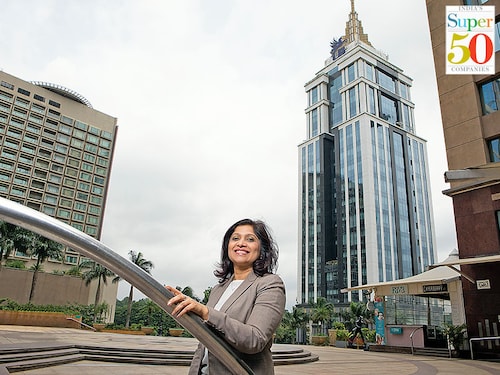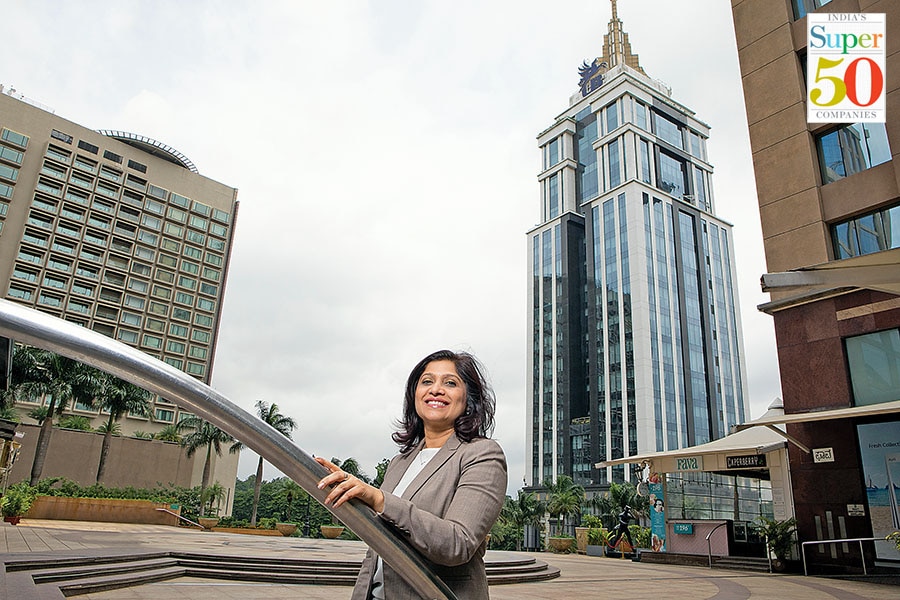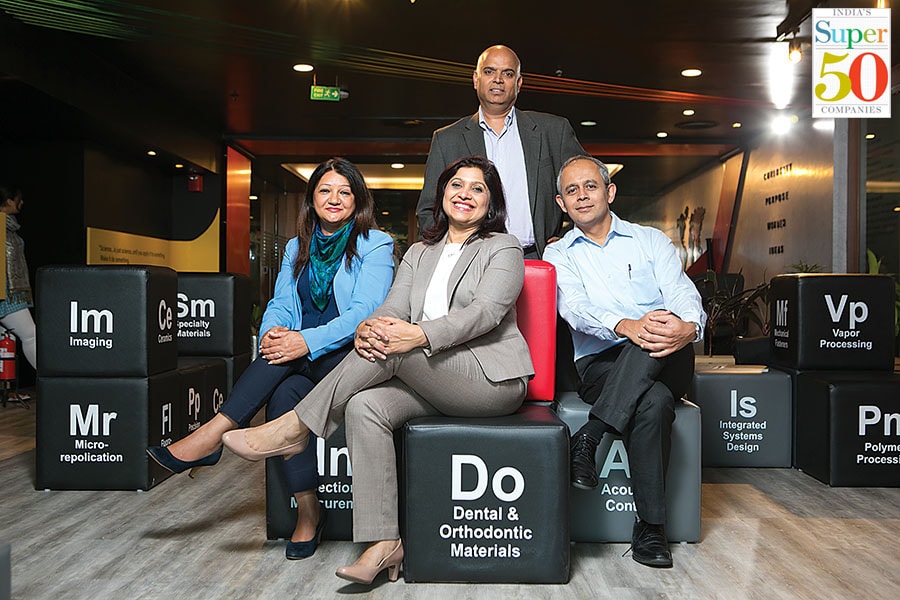3M India: Dial M for efficiency
With MD Debarati Sen's focus on the customer, 3M India has seen its revenue and profits soar over the last few years. Now, 3M Company in the US is following suit


 Debarati Sen is among a handful of women heading MNCs in India
Debarati Sen is among a handful of women heading MNCs in India
Image: Selvaprakash Lakshmanan for Forbes IndiaIt was a chance encounter with a college mate at a pub in Bengaluru (then Bangalore) in 1996 that got Debarati Sen to 3M India, the listed India entity of the $32 billion (by revenues), US-based diversified technology and science major 3M Company. Sen was at an office outing at the erstwhile Black Cadillac pub on Residency Road with her colleagues from advertising firm J. Walter Thompson when she met her senior from Jamshedpur’s Xavier School of Management.
“He, [then the HR manager at 3M India], asked me what I was doing in advertising when I was an engineer,” recalls 50-year-old Sen, a graduate from Maulana Azad National Institute of Technology, in Bhopal. After all, Sen was quite an accomplished student, having secured a full scholarship and a book allowance for her bachelor’s degree in electronics engineering. Given her qualifications, he informed Sen about an opening in the company’s electronics business vertical.
Within two days of meeting him, Sen interviewed for the job and got it. “Of course, everybody knows about 3M. At business school, there are many chapters referencing 3M in [books by the management expert Philip] Kotler,” says Sen. But she admits, “I didn’t know about [all] their products, but I knew about Post-it, Scotch-Brite, Scotchgard.”Rightly so, as 3M Company is a multi-faceted enterprise with a wide range of products, both industrial and consumer focussed, that have uses across electronics, energy and health care, among other industries.
Two decades on, Black Cadillac is a pub of the past and Sen’s friend has long moved out of 3M India. Sen, however, is the company’s managing director, having taken charge in June 2016. She’s among a handful of women who are heading multinational companies in India, Kalpana Morparia of JP Morgan India, Rekha M Menon of Accenture and Nivruti Rai of Intel India being a few others.
For a layperson in India, 3M Company can be easily associated with its stationary product Post-it and utensil cleanser Scotch-Brite. You also have 3M screen guards for mobile phones and 3M respiratory masks, both of which are well-established products. Another easily identifiable 3M consumer brand is 3M Car Care centres, numbering over 100 across the country.
What is little known, though, is that 3M products are used widely in hospitals, pre- and post-surgery. For example, the 3M Ioban, an iodine-based antimicrobial drape, secures a surgical site on a body, while 3M Tegaderm is a transparent dressing that is used widely in clinics. Besides, some of the company’s industry-focussed products are used to secure power cables from water, and in the protection of pipes at oil refineries.
“We are essentially a material science company—materials that are used to enhance the performance of other materials or processes,” says Sen, who began her career with Vijay Mallya’s UB Group in 1992. She was then the product manager for white spirits such as Blue Riband gin and the erstwhile Red Riband vodka. The highlight, she says: “I sold liquor in Kamathipura [Mumbai’s red light area]!”
In 1998, 3M India began its journey as Birla 3M Ltd, a joint venture between 3M Company and the Birla Group. In 1991, Birla 3M India was listed on the Indian stock exchanges and only in 2002 did the company’s name change to 3M India Ltd. It’s the only listed 3M Company subsidiary. As of the quarter ended June 30, 2018, 3M Company holds a 75 percent stake in 3M India (the Birlas have exited). The company’s share price has increased 87 percent since Sen took charge—from ₹12,844 in June 2016 to ₹23,998 as on August 2018 (monthly average price). The Sensex rose 40 percent in the same period.
The stock seems to be riding high on its financial performance in the same period. Since FY16, 3M India’s profit has surged 55 percent to ₹310.54 crore and revenue by 23 percent to ₹2,580.40 crore.
“3M India operates in areas that are either of importance or have high growth potential for India—automotive, health care, infrastructure etc,” says Ankur Bisen, senior vice president, Technopak, a retail consultancy firm. “In a nutshell, 3M products, either B2B (business to business) or B2C (business to consumer), stand to benefit as India [growth story] provides good tailwinds for the company.”[qt] 3M India operates in areas that are either of importance or have high growth potential.[/qt]
“I can’t say it’s just because of me,” says Sen, when asked about the company’s financial performance. But one can’t deny it’s her unyielding focus on customers, portfolio prioritisation, and operational productivity that has been the driving force of the company’s continued high-growth trajectory over the last few years.
The company has also expanded its footprint to include the eastern and north-eastern regions of the country, which have contributed about 20 percent of its overall growth. Besides, its reach to small and medium businesses has been further enhanced through the B2B ecommerce channel. And with over 10,000 products being sold in India, innovation for the local market—its range of floor cleaning products, infection-prevention products for hospitals, tamper-proof labels, traffic and safety products etc—has also been a growth enabler.
“3M India has established a quiet but very strong play in the Indian market,” says brand expert Harish Bijoor. “The company has used its superlative product quality and innovation strength to squeeze higher margins in spaces [like kitchen products] which were literally commodity spaces in India for long.”
 Sen’s core team comprises Mamta Gore (extreme left), a 3M veteran who took charge as CFO in April Kris Sridhar (standing) who heads 3M India’s 100 researchers and Ninad Gadgil (extreme right), VP-health care business
Sen’s core team comprises Mamta Gore (extreme left), a 3M veteran who took charge as CFO in April Kris Sridhar (standing) who heads 3M India’s 100 researchers and Ninad Gadgil (extreme right), VP-health care business
Between 1996 and 2002, Sen oversaw the operations of 3M India’s personal safety business that include worker protection products. In 2002, she got a chance to move to 3M Company’s headquarters in Saint Paul, Minnesota, US to run the same personal safety division. Then, in 2011, she left 3M to join Pentair, a diversified industrial company, only to return a year later as 3M’s head of oil and gas business, then about $700 million in revenue. Since then, Sen has held key global positions in 3M Company.
About a year before she returned to India, Sen had informed the 3M Company leadership that she was ready for a role in another country. “I put my hand up because by then my son had started college,” says Sen, a single mother. So when the company came back to her with an offer to head its India business, it was more than what she had wished for. “In my meetings, even the head of international said there are very few countries like India the runway [for growth] he saw ahead for India was unparalleled,” adds Sen. Within two weeks, she was on ground in India, in 2016, meeting her team.
About two years later, on April 1 this year, Mamta Gore, who’s a chartered accountant, took over as CFO of the company. She’s no stranger to the workings of 3M Company as she has spent 24 years at 3M Gulf Ltd operating in various finance roles. Before taking over as the finance head of 3M India, Gore says, “I did my homework and looked at how they [the management] have transformed 3M India in the last few years.” The company’s financial success, she says, is in large part, on account of its “customer-first approach”. While it can be said that 3M Company’s approach to business is to work with its customers and find solutions to their problems, Gore says, “3M India’s customer-first approach appears to be driven with greater enthusiasm and zest in the past few years.” And it seems to have Sen’s personal stamp on it.
Typically, automotive companies keep scorecards wherein a zero rating means no quality defects and no service issues. Sen keeps similar scorecards handed out by customers on her bulletin board at her corner office on the eleventh floor of UB City, in Bengaluru’s Central Business District. (Interestingly, the adjoining building is the corporate head office of the UB Group, her first employer.)
“We want to make sure that we give them [our customers] the best. We are saying evaluate us and tell us how we are serving you,” says Sen of the scorecards. “I measure my operating committee along with me based on our customer scorecard metrics.” And the result has been more than satisfactory.
“We are ranked as the number one vendor for the nation’s largest car maker for several months in a row. Two years ago, we were ranked somewhere around 373,” says Sen. “This customer-first piece is helping us win with our customers. And once you win competitive share, you can secure your position by working hard as an organisation to maintain that.”
To be fair, when Sen took over, 3M India had already turned around from its low-growth years—its profit had fallen to a low of ₹52.26 crore in FY13 from ₹98.80 crore in FY11. “My predecessor [Amit Laroya, who was the CEO from October 2013 to May 2016] did a fantastic job of addressing profitability challenges,” says Sen. “We had essentially got ahead of the demand curve, and the policy environment was sluggish to boot. My predecessor aligned the organisation with the market demand,” she adds. Likewise, she, too, assessed the market to find sectors where there was a confluence of demand and policy initiatives by the government.
Road infrastructure was one such sector where 3M’s truckload of products—reflectors, markers and signages—had immense potential. “Roads were being laid in India at a rate of 8 km a day in 2013. It moved to 22 km last year and the expectation is 41 kilometres a day next year,” says Sen.
Moreover, 3M India has set up 160 Variable Messaging Sign (VMS) systems in Pune, which provide commuters with real-time updates on weather, traffic and air quality, among other things. While this cloud-based service was specifically developed for the Smart Cities initiative by 3M India’s R&D centre in Bengaluru, Kris Sridhar, executive director—R&D, 3M India, says, “These VMS products can be easily replicated in several global events. One such event that we are in discussion for is the 2020 Tokyo Olympics.”
Sridhar heads a team of over 100 researchers whose primary objective is to look at growth opportunities in the local market as well as see how best 3M Company’s global products can fit into the local market. At present, his team is working on a polymeric fibre broom that will have the same feel as a regular broom, but would be lighter and pick up dust better.
As every dollar of growth is not the same, Sen and her team also undertook a portfolio rationalisation across divisions and just focussed on products that delivered better productivity and profitability to customers. “Through disciplined portfolio and product prioritisation, I would imagine that we rationalised approximately 30 to 35 percent of SKUs across business lines,” says Ninad Gadgil, country business leader—health care business, 3M India.
Such customer-centricity has not only benefitted 3M India the parent company, too, is taking a leaf out of Sen’s book. 3M Company’s automotive division, she says, now plans to adopt the scorecard method. “I thought to myself, ‘this is how we should run our enterprise towards greater success’,” says Sen. Perhaps this is how the world ought to run it too.
First Published: Aug 23, 2018, 14:56
Subscribe Now